吐血整理 | 【跑步的奥秘】北京分享会图文总结
2015年4月2日,【NoBusyLife】跑团的Jinglei、望小朔、路飞、MC以及米米一同参加了由新星出版社和爱燃烧运动社区联合组织的【跑步的奥秘,罗曼诺夫博士中国巡回分享会-北京站】活动。这是一场关于跑步知识的分享会,在会上罗曼诺夫博士让我们了解了什么是正确的跑姿、如何提高跑步效率等等问题。Jinglei和米米将分享会上的PPT拍摄了下来,以供未能到现场的朋友参考学习。不过害怕有遗漏,特别找了主办方爱燃烧的朋友要了文字版,我会两个一同贴出。(最后整理后发现还是会缺少一两张PPT的图片,请大家见谅)
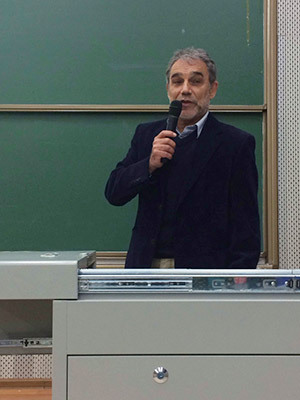
尼可拉斯·罗曼诺夫博士
《跑步,该怎么跑?》作者
Pose Method of Running
跑步,该怎么跑?
Running faster, longer and Injury- free By Dr. Nicholas Romanov
学会「姿势跑法」,提高跑步效能、不受伤 尼可拉斯.罗曼诺夫博士
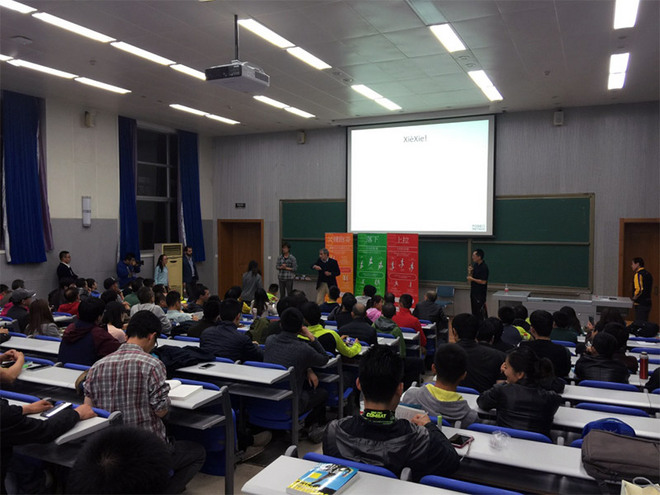
Born to run- myth and reality
人类天生就会跑──谜思与事实
· Do we possess the running skill from our birth?
· 人类一出生就會跑步技巧吗?
· What makes us the good runners?
· 什么使人类成为优秀的跑者?
· We are created by our world (J. Gibson. 1979)
· 我们由所处的世界所创造了 (J. Gibson. 1979)
· Greeks and their legacy
· 希腊人和他们的传统
Let’s define running
让我们先给跑步下定义
· Horizontal Transferring body from point “A” to “B”
· 把身体从A点水平移动到B点
· Moving body from one leg to the other
· 利用双脚轮流支撑移动身体
· Faster than walking
· 比走路快
What’s natural running?
什么是天生的跑法?
· Natural is translaVon from the Greek “Physike” – meaning, the origin, beginning...
·「天生」是从希腊文「Physike」翻译而来, 意指「起源」和「开始」......
What’s natural running?
什么是自然的跑法?
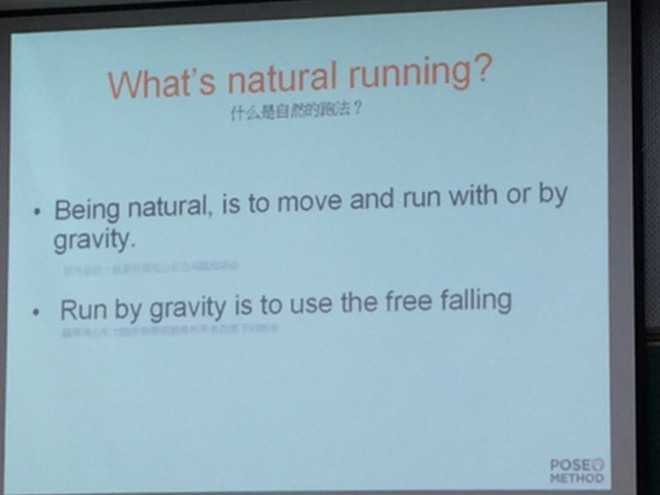
· From this point of view the origin is the primary factor of the surrounding, which is the gravity, which has been exisVng before anything else
· 从这点来看,地心引力是周遭万物之所以存在的最早起源
· Being natural, is to move and run with or by gravity.
· 回归自然,就要利用地心引力来跑和移动
· Runbygravityistousethefreefalling
· 藉用地心引力跑步的要领就是利用自然落下的概念
Different people, different technique?
跑步技术因人而异吗?
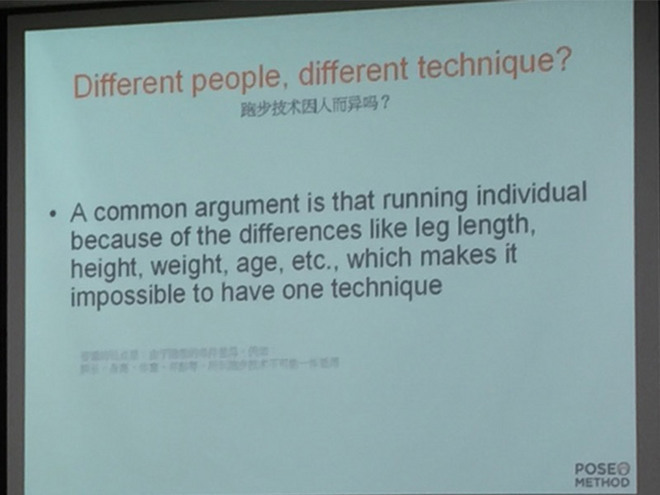
· A common argument is that running individual because of the differences like leg length, height, weight, age, etc., which makes it impossible to have one technique
· 普遍的论点是:由于跑者的条件差异,例如: 脚长、身高、体重、年龄等,所以跑步技术不可能 一体适用
· Does different running speed require different mechanics?
· 在不同的速度下需要不同的技巧吗?
· Does bench press require a different set of mechanics for different people?
· 重量训练中的「卧推」(bench press)动作会因人 而异吗?
What are the common elements of running?
跑步的基本要素有哪些?
·Pictures of runners from the different 1mes, distances
· 跑者在不同时间和距离下的照片
· The Pose....
· 姿势......
· The Falling...
· 落下......
· The Pulling...
· 拉起......
Let’s compare elements of running side by side
跑步元素的对照比较
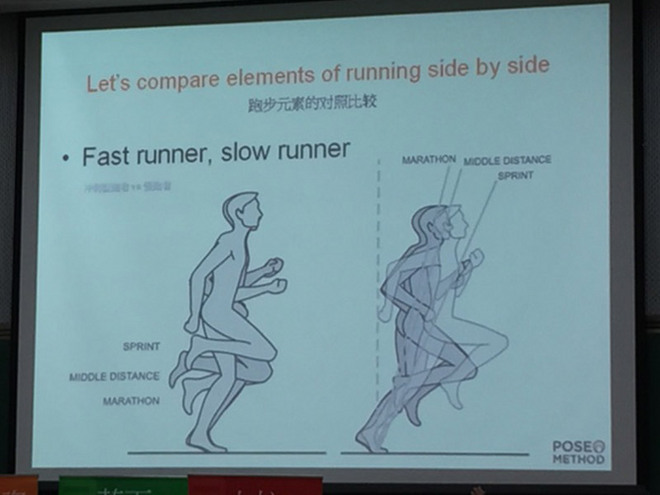 · Short person, tall person
· Short person, tall person
· 身材矮小 vs 高个子
· Fast runner, slow runner
· 冲刺型跑者 vs 慢跑者
· Breakdown of elements
· 拆解跑步的元素
Said Auita – Infinite Poses
塞德·奥维塔(Said Auita)-无数的姿势
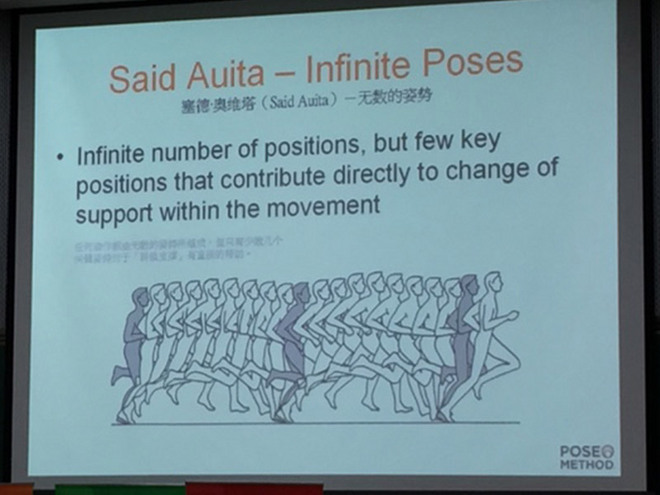
· Infinite number of posiVons, but few key posiVons that contribute directly to change of support within the movement
· 任何动作都由无数的姿势所组成,但只有少数几个 关键姿势对于「转换支撑」有直接的帮助。
Poses of the different runners
不同跑者的姿势
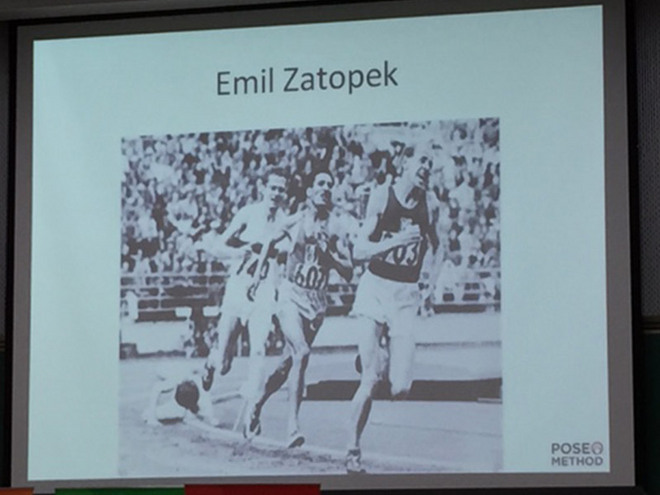
History of the Pose Method
姿势跑法的历史
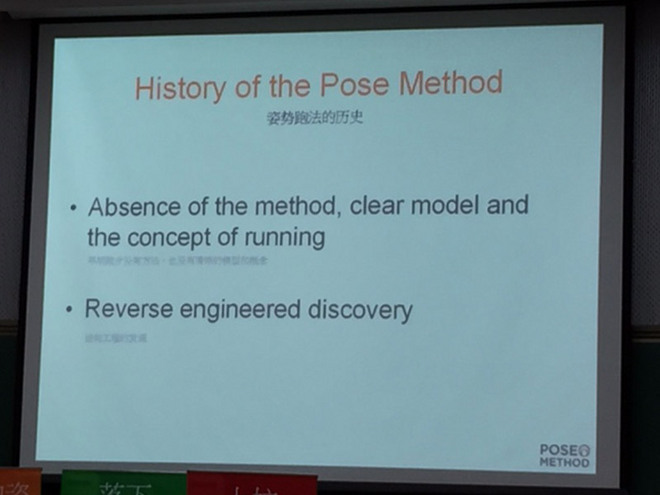
· Absence of the method, clear model and the concept of running
· 早期跑步没有方法,也没有清晰的模型和概念
· Reverse engineered discovery
· 逆向工程的发现
· Anatomy of a running stride
· 步态剖析
· Every runner goes through the Pose posiVon
· 每一位跑者都会经历关键跑步姿势
· More on fall, pull later
· (脚掌)落下的时间愈久,拉起的愈晚
Why this Pose?
为何是此种姿势?
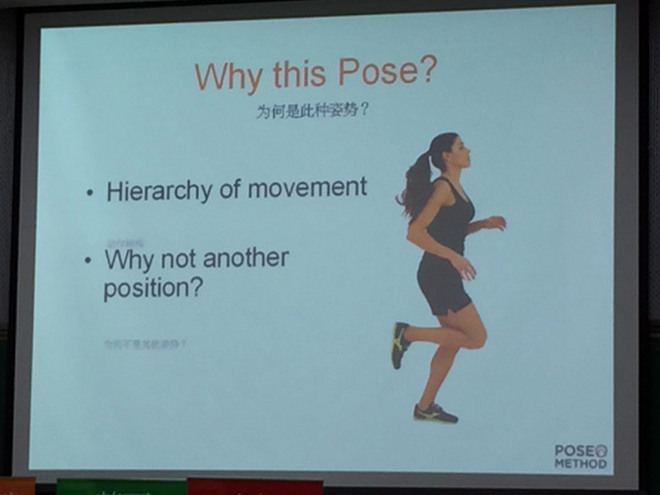
· Hierarchy of movement
· 动作结构
· Why not another posiVon?
· 为何不是其他姿势?
· Every funcVonal movement has an opVmal sequence of posiVons.
· 每一种功能性动作都有一连串的最佳姿势
– Consider defined movements like a snatch or deadli
- 想看看如何定义抓举(snatch)和硬举(deadlift) 的动作
· This position is optimal for horizontal acceleration in the forward direction and is replicated every stride
· 这是水平向前加速时的最佳姿势,每步都会重复 一次
What about Footstrike?
脚掌的着地方式?
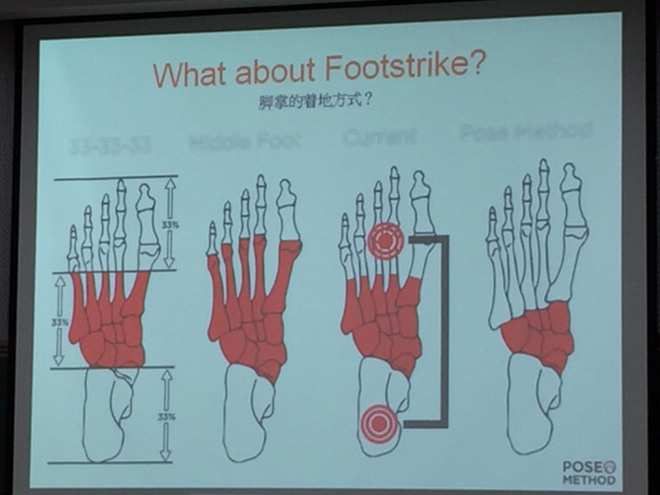
· Research of the Tony Ne` (1986)
· 柬尼·奈特(Tony Nett)的研究(1986)
· pictures (US 10k trial)
· 照片(美国,10公里测验)
· Heel Strike
· 脚跟着地
·Mid-Foot Strike–MarkeVng & a problem with classificaVon
· 中足着地—常见的问题类别
– Research that arbitrarily split the foot region into 3 equal parts (no a`enVon to anatomy of foot)
– 把脚掌分割成三个部分来研究 (我们先撇除脚掌的解剖构造)
· Cavagnah et al 1980
· Cavagnah等人在1980年的研究
· Also noted that with such an arbitrary split, no runners were found to be forefoot strikers
· 值得注意的是,在这项研究中没有跑者是用前足着地
– Research that suggest a mid-foot strike is when the foot hits front and back simultaneously
– 研究指出中足跑法的前脚掌与脚跟会同时落地
–Note: neither occurs when performed barefoot
– 注记:此种情况不会发生在赤脚跑时
· Forefoot Strike
· 前足着地
– IniVal contact begins on the outside of the foot in a slightly supinated, lateral ball of the foot, followed by the enVre foot contact (with weight/pressure concentrated on the ball of the foot) and ends around the big toe at last point of contact
–脚掌在最初接触地面时会先以外侧着地,同时略微外旋,接 着是跖球部触地,再来则是整个脚掌(体重/压力集中落在跖球部上),离地前,脚掌与地面接触的最后一个部位是大脚趾。
Now that you know about Footstrike, forget about it – (move it)
现在知道脚掌着地动作了, 再来就是忘了它──(动就好了)
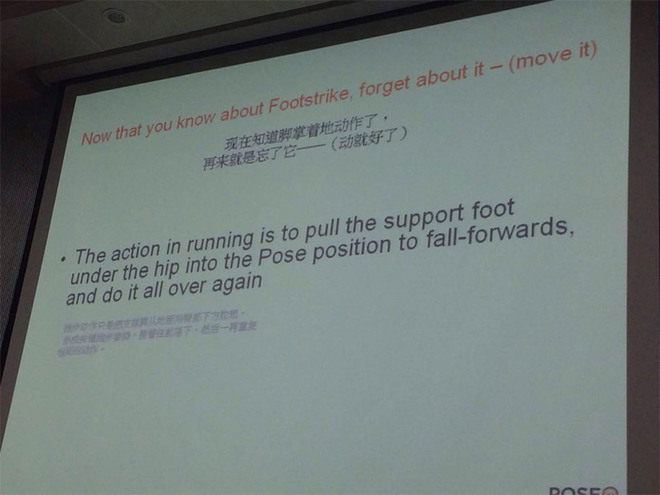
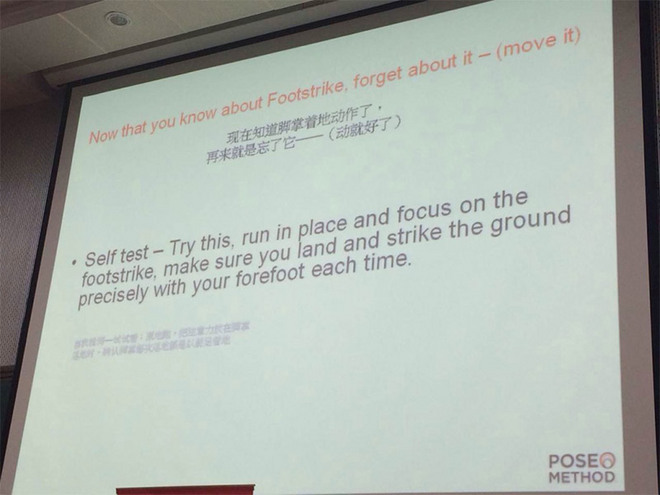
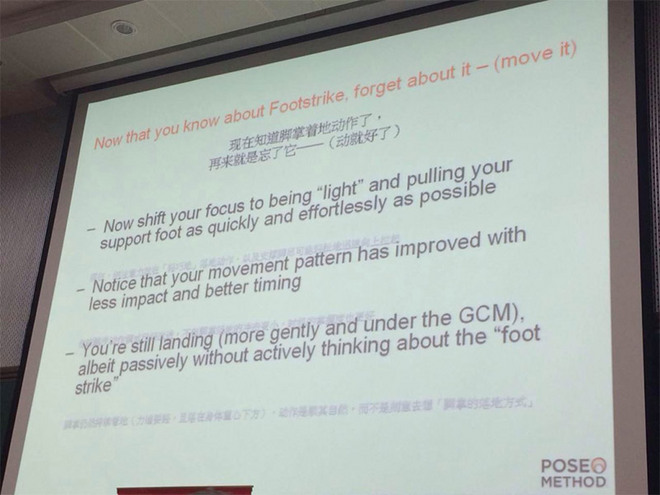
· The acVon in running is to pull the support foot under the hip into the Pose posiVon to fall-forwards, and do it all over again
· 跑步动作只是把支撑脚从地面向臀部下方拉起, 形成关键跑步姿势,接着往前落下,然后一再重复相同的动作。
· Self test – Try this, run in place and focus on the footstrike, make sure you land and strike the ground precisely with your forefoot each Vme.
· 自我检测—试试看:原地跑,把注意力放在脚掌 落地时,确认脚掌每次落地都是以前足着地
- Now shi_ your focus to being “light” and pulling your support foot as quickly and effortlessly as possible
- 现在,把注意力放在「轻巧地」落地动作,以及支撑脚尽可能轻松地迅速向上拉起
- NoVce that your movement pa`ern has improved with less impact and be`er Vming
- 你的跑步动作模式已经改进,不但脚掌落地的冲击变小,时机的掌握度也更好
- You’re sVll landing (more gently and under the GCM), albeit passively without acVvely thinking about the “foot strike”
- 脚掌仍然持续着地(力道要轻,且落在身体重心下方),动作是顺其自然,而不是刻意去想「脚掌的落地方式」
Anatomy of a Running Stride
跑步的步态剖析
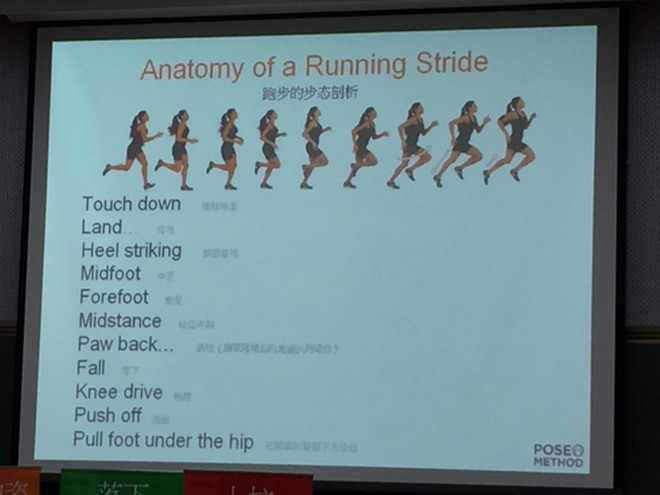
· Touch down接触地⾯面
· Land...落地
Heel striking 脚跟着地
Midfoot中足
Forefoot 前足
Midstance 站立中期
Paw back...
扒地(脚掌落地后向地面扒的动作)
Fall 落下
Knee drive 抬膝
Push off 推蹬
Pull foot under the hip
把脚掌向臀部下⽅方拉起
What regulates speed?
控制速度的快慢的因素?
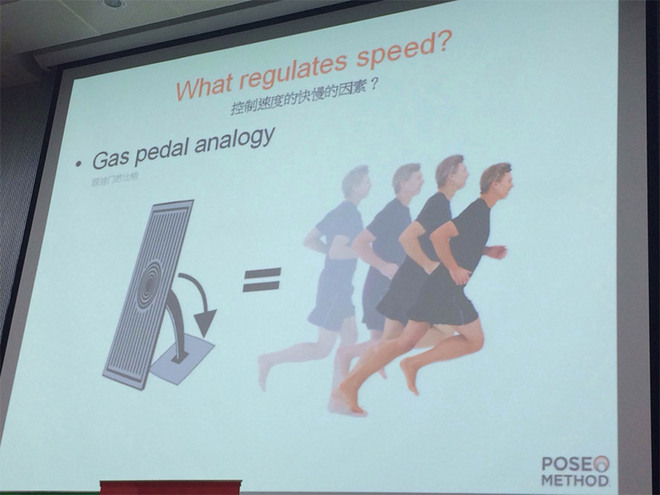
· It’s not arm pumping
· 并非手臂的摆动
· It’s not cadence, or range of moVon
· 并非步频或动作幅度
· Jump down faster
· 快速向下落
· Gas pedal analogy
· 踩油门的比喻
· It’s falling forward (from verVcal Pose posiVon) each stride up to 22.5 degrees
· (从直立的关键跑步姿势)向前落下,角度最高到22.5度
· -Taller runner(U. Bolt have speed advatange (up to a point),but it comes at the price of endurance.
· 身高较高的跑者(U.Bolt)具有速度上的优势(在一定程度 上),但必须以耐力作为代价
Fall-Forward
向前落下
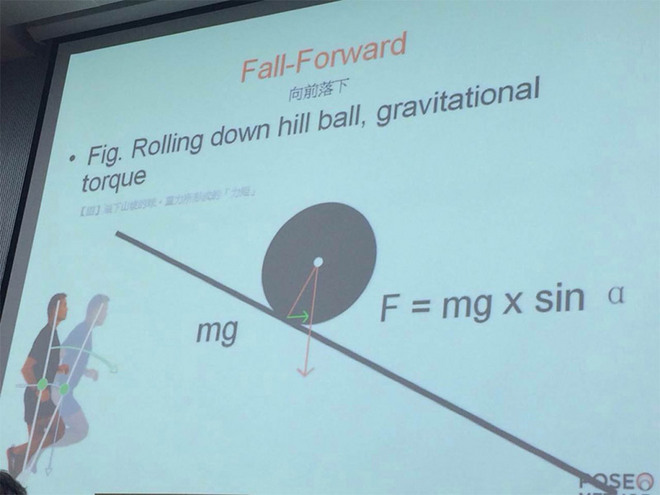
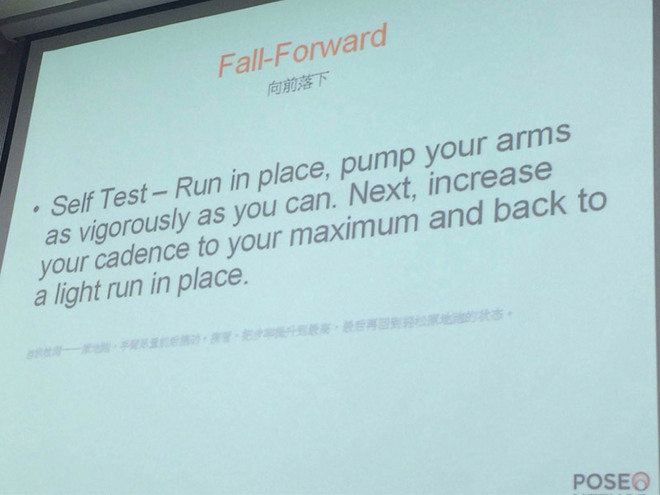
·Fig. Rolling down hill ball, gravitaVonal torque
· 【图】滚下山坡的球。重力所形成的「力矩」
· Self Test – Run in place, pump your arms as vigorously as you can. Next, increase your cadence to your maximum and back to a light run in place.
· 自我检测──原地跑,手臂尽量前后摆动
。接着,把步 率提升到最高,最后再回到轻松原地跑的状态。
– NoVce that the most vigorous arm pumping and cadence does not move you forward.
- 请注意:当你用尽全力摆动手臂和提高频率时,并无法使你向前移动
– What does move you forward?
- 会让身体前移动的方式是什么?
· Shi_ing your weight ahead of your support.
· 把体重转移到支撑点的前方
– Falling-forward
向前落下
Pull
向上拉
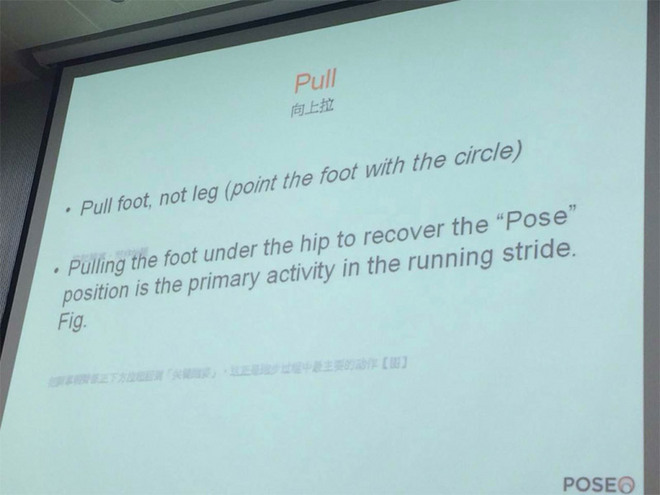
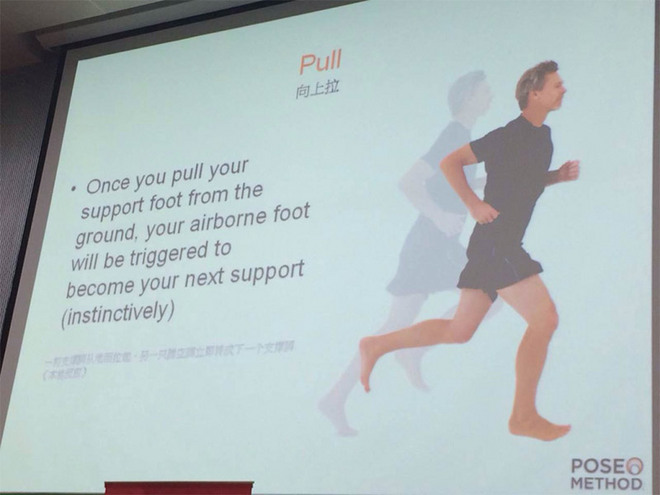
· Pull foot, not leg (point the foot with the circle)
· 拉起脚掌,而非抬腿
· Pulling the foot under the hip to recover the “Pose” posiVon is the primary acVvity in the running stride. Fig.
· 把脚掌朝臀部正下方拉起回到「关键跑姿」,这 正是跑步过程中最主要的动作【图】
· Once you pull your support foot from the ground, your airborne foot will be triggered to become your next support (insVncVvely)
· 将支撑脚从地面拉起,另一只腾空脚立即转成下 一个支撑脚(本能反应)
· How it all happens?
运作的机制?
· TransformaVon of energy
· 能量的转换
– Movement is redirected not created by muscles
- 移动是靠肌肉重新导向能量的结果,而非靠肌肉产生能量
· Hierarchy of forces
· 力量的层次结构
Arm Swing
手臂的摆动
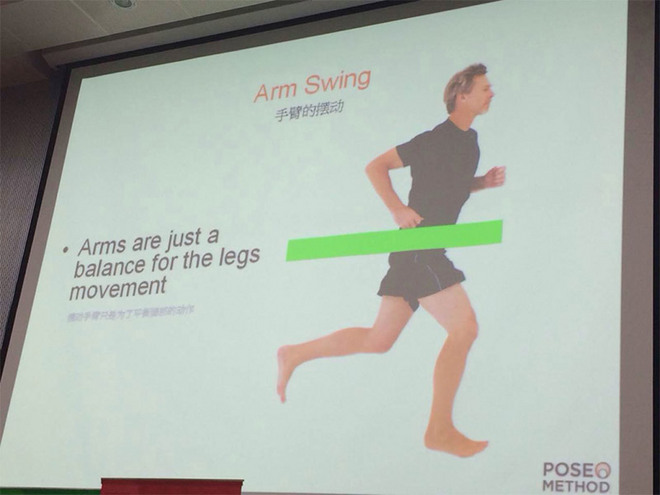
· Arms are just a balance for the legs movement
· 摆动手臂只是为了平衡腿部的动作
Cadence & ElasVcity
步频与弹力
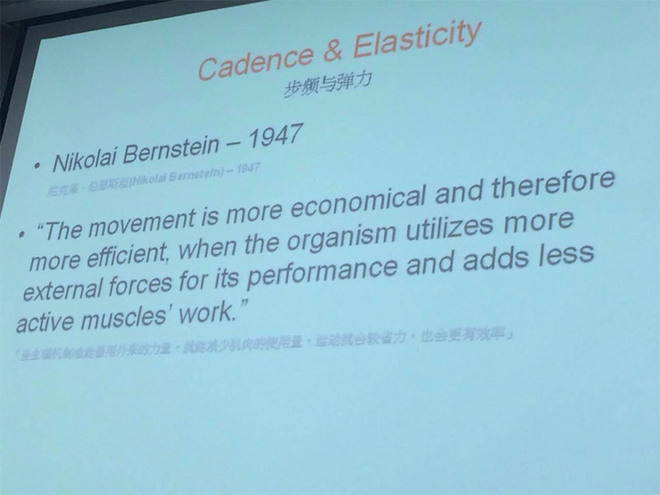
· Nikolai Bernstein – 1947
· 尼克莱.伯恩斯坦(Nikolai Bernstein) – 1947
· “The movement is more economical and therefore more efficient, when the organism uVlizes more external forces for its performance and adds less acVve muscles’ work.”
· 「当生理机制愈能善用外来的力量,就能减少肌肉 的使用量,运动就会较省力,也会更有效率」
· 180+ and elasVc component, J. Daniels, 1998, Margaria, Sabiene & Cavagna, 1964
· 每分钟180以上的步频与弹力的关系,(J. Daniels, 1998 Margaria, Sabiene & Cavagna, 1964)
More steps won’t hurt your economy
步频愈高,愈不会伤害你的跑步经济性
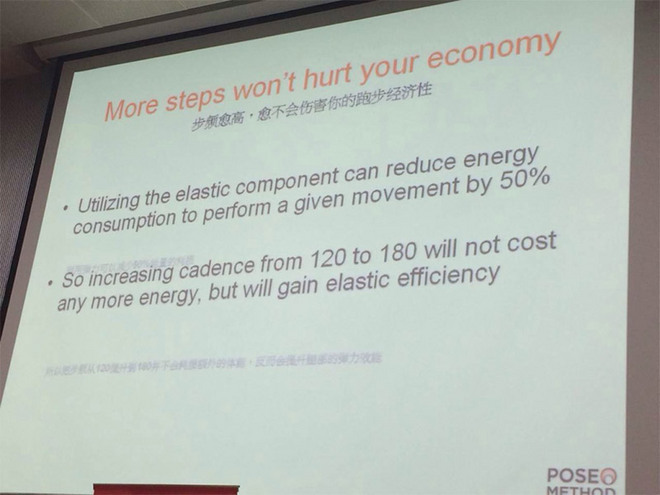
· UVlizing the elasVc component can reduce energy consumpVon to perform a given movement by 50%
· 利用弹力可以减少50%能量的耗损
· So increasing cadence from 120 to 180 will not cost any more energy, but will gain elasVc efficiency
· 所以把步频从120提升到180并不会耗损额外的体 能,反而会提升腿部的弹力效能
Role of forces – foundaVon, gravity
外部力量的基础是重力
· Gravity iniVates all movement, muscles redirect
· 重力,启动一切的动作,藉由肌肉重新引导重力 的方向
· GravitaVonal torque- mg·r·sinα
· 重力所形成的「力矩」=mg.r.sinα
Errors are magnitude of deviaVon from the standard
错误是标准姿势偏差后放大的结果
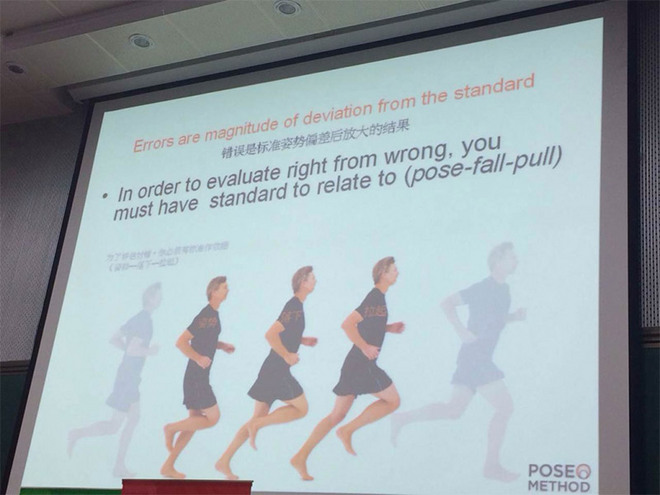
· In order to evaluate right from wrong, you must have standard to relate to (pose-fall-pull)
· 为了评估对错,你必须有标准作依据 (姿势—落下—拉起)
Common Technique DeviaVons
技术上常见的偏差
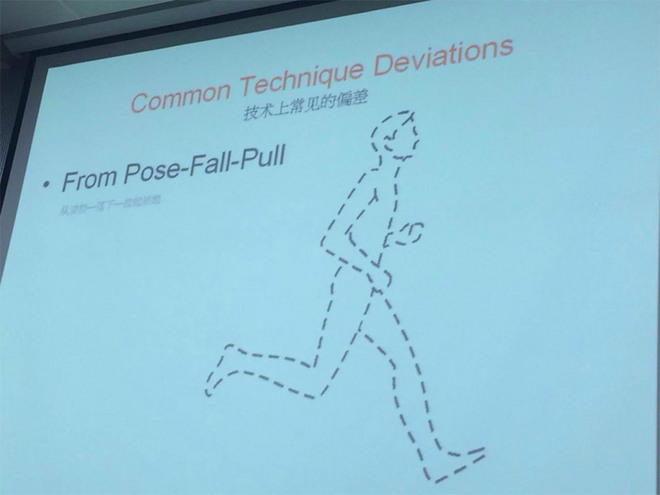
· From Pose-Fall-Pull
· 从姿势—落下—拉起谈起
Self CorrecVon Drills
自我修正的技衔训练动作
抱歉此处无图无文字。
Injury PrevenVon
避免受伤
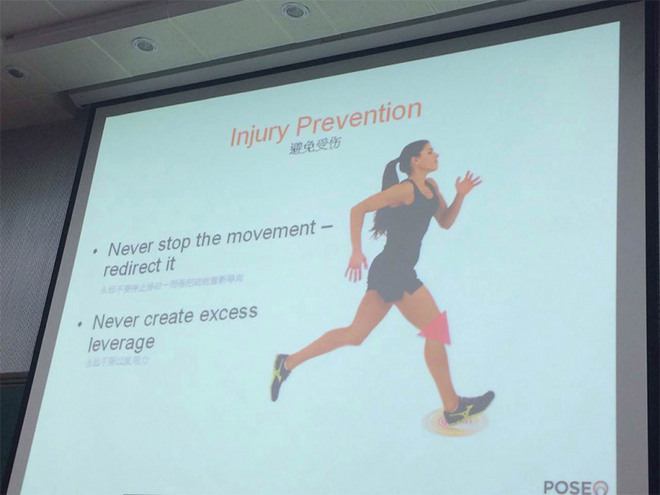
· Never stop the movement – redirect it
· 永远不要停止移动-而是把动能重新导向
· Never create excess leverage
· 永远不要过度用力
Shoe advice
选购鞋子的建议
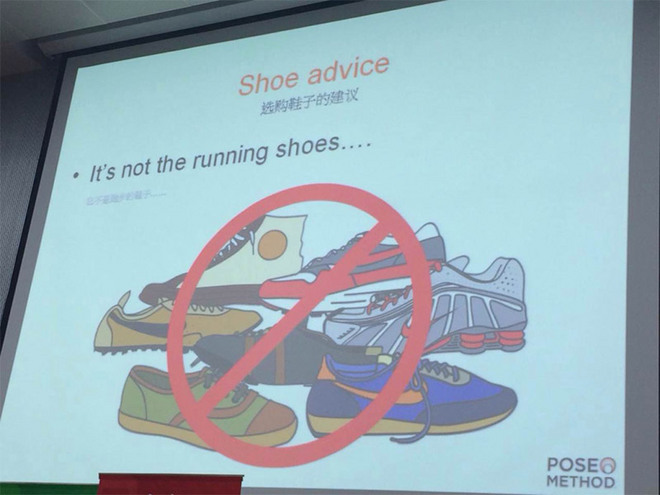
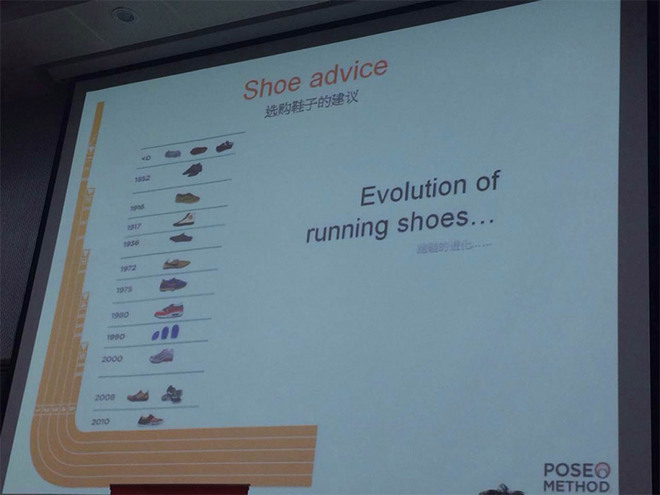
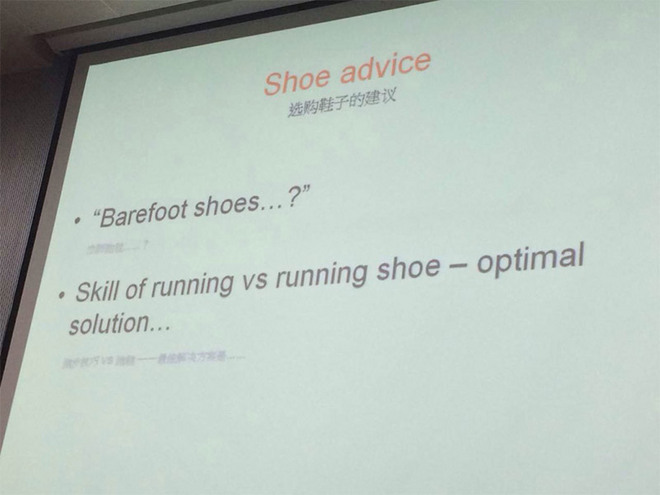
· It’s not the running shoes....
· 它不是跑步的鞋子......
· EvoluVon of running shoes...
· 跑鞋的进化......
· “Barefoot shoes...?”
· 赤脚跑鞋......?
· Skill of running vs running shoe – opVmal soluVon...
· 跑步技巧 VS 跑鞋 ──最佳解决方案是......
选择一款专业的跑鞋,能保护你的双脚。
注:
本次活动现场,由尼可拉斯·罗曼诺夫博士主讲,来自台湾的徐国峰作为翻译顾问主持现场。以下为二人的个人简介,内容来自《跑步,该怎么跑》一书。
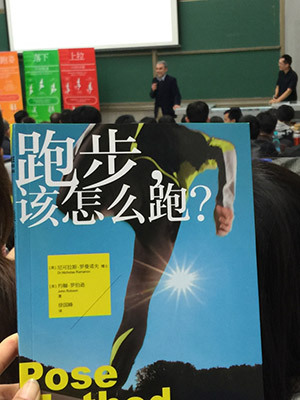
尼可拉斯·罗曼诺夫博士 | 作者
在俄罗斯出生与受教育,后搬到美国发展。曾于2000年、2004年和2012年担任奥林匹克国家队教练。他是一位有着40多年科研经验的运动科学家,专业设计运动生物力学、运动学生理学、运动训练理论与体育教学、培训计划的制定从专业到业余、运动损伤的诊断,预防和康复锻炼等多领域。他花了25年时间创立并完善“姿势跑步法”体系,并将其推广到全世界,成为无数跑者公推的行动指南。
徐国峰 | 译者
从小热爱运动,就读台湾清大化工系时加入游泳队,从那时起开始从事游泳、体能训练,大三担任泳队副队长,大四担任队长。2006年毕业,取得清大化学工程学士学位,清大外国语文学系辅系,尔后投考东华大学中文所毕业。目前为铁人三项选手。
本文著作权归作者本人所有,未经许可不得转载。文章仅代表作者看法,不代表本站观点。如有不同见解,原创频道欢迎您来分享。来源:爱燃烧 — http://iranshao.com/diaries/493







回应
回应
回应
回应
回应
回应
回应
回应
回应
回应
回应
回应
回应
回应
回应
回应